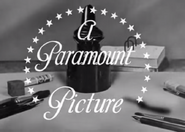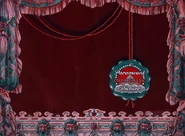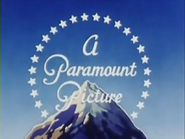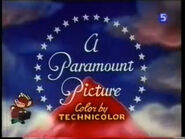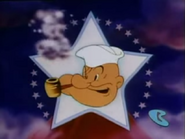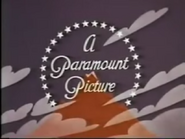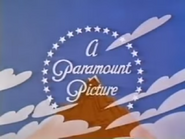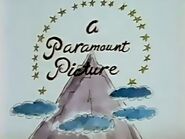Note: This is a Work in Progress
1st Logo (1927-1929)
Logo: On the film's title card, a small mountain logo is seen circled by stars. The words "A Paramount Picture", in a script font, appear in a single line across the mountain.
FX/SFX: None.
Music/Sounds: None.
Availability: Extinct. This logo appeared on the Inkwell Imps cartoons of the day and were removed when the titles were deleted for UM&M prints. Spotted on a print of Koko the Kop.
2nd Logo (1931-1932)
Logo: On a wall-like background, in a hole with a border of encircling stars, there is a mountain with clouds in the background. The script words "A Paramount Picture" are in front of the mountain. A group of clouds lines the bottom of the wall.
End Title: On the wall background, the words "The End" are written in a fancy font. It then fades to the opening logo.
FX/SFX: None.
Music/Sounds: A fanfare based on "Paramount on Parade" or the cartoon's opening theme.
Availability: Extremely rare. This logo has been plastered over by the UM&M or NTA logo on current prints. Surprisingly, it was saved on the Talkartoon short Any Rags and the Screen Song Down Among the Sugar Cane.
3rd Logo (1932-April 28, 1939)
Nickname: "30s Toon Mountain"
Logo: Against a multi-colored sky backdrop is a three-dimensional dark-colored mountain surrounded by a round border of 23 stars. By the top of the mountain are the words:
A
Paramount
Picture
in the Paramount font.
Variants:
- Early cartoons with this logo had 24 stars.
- A black-and-white version is seen on Talkartoon, Screen Song, Betty Boop, and Popeye cartoons.
- For shorts featuring live-action model sets, a special byline appeared on the logo. It reads: "PATENT PENDING FOR SPECIAL PROCESSES USED IN THIS PRODUCTION". Later on, the byline was revised to read "STEREOPTICAL PROCESS and APPARATUS PATENTED. PATENT NUMBER 2054414".
- On the Color Classics short Poor Cinderella, the logo is very small and part of a closing curtain background. Also, the words "COLOR CLASSIC" are seen between "Paramount" and "Picture".
- On shorts from around 1933-34, a special end title was used. The cartoon irises out into an open inkwell lying on a desk. After the cartoon ends, the inkwell stands up all by itself and the cork does a flip and caps it. The words "A Paramount Picture", the stars and the words "The End" appear over the inkwell. This version has an extra star.
- On Screen Song cartoons from 1932-33, the closing shot of a live-action performer would have the Paramount print logo of the time superimposed over the shot. This is usually plastered on UM&M/NTA prints, but is intact on Ain't She Sweet?.
- A color version with blue sky, yellow stars and with the Stereoptical byline was spotted.
FX/SFX: The flowing clouds in the background.
Music/Sounds: The beginning/end of a cartoon's theme music. On some 1932 shorts, a fanfare based on "Paramount on Parade" is heard.
Music/Sounds Variant: On the Screen Song short Kitty from Kansas City and the Talkartoon short Chess-Nuts, a different version of the fanfare is heard.
Availability: Uncommon. Seen on the Popeye the Sailor DVD series from Warner Home Video. This, along with subsequent logos, may be more visible if the non-Popeye shorts are restored with the original logos intact. Survives on 1980s video prints of the Talkartoon short Minnie the Moocher, and also on the Screen Song short Ain't She Sweet? and several Color Classics. The 1933-34 closing title was seen on Betty Boop, Popeye the Sailor and Screen Song cartoons.
4th Logo (Late 1938-September 3, 1943)
Nickname: "3-D Mountain"
Logo: Against a multi-colored sky backdrop is a three-dimensional light-colored mountain surrounded by a round border of 24 stars. By the top of the mountain are the words:
A
Paramount
Picture
in the Paramount font.
Variants:
- Used the following byline on the opening of some shorts: "STEREOPTICAL PROCESS and APPARATUS PATENTED. PATENT NUMBER 2054414". Replaced with "in TECHNICOLOR" at the end of most color shorts.
- Like the previous logo, Popeye and Betty Boop cartoons featured this logo in black & white.
- On Mr. Bug Goes to Town, the logo is on a book-like background.
FX/SFX: Just the flowing clouds in the background.
Music/Sounds: The beginning/end of a cartoon's theme music.
Availability: Can be seen on Popeye and Superman shorts on DVD from Warner Home Video. The logo made its final appearance on the Popeye cartoon Cartoons Ain't Human, released on September 3, 1943.
5th Logo (November 26, 1943-November 12, 1954)
Nickname: "40s Toon Mountain"
Logo: Against a blue sky with white clouds is a red mountain surrounded by a round border of 24 stars. By the top of the mountain are the words:
A
Paramount
Picture
in the Paramount font. Usually at the end of the film featured the following byline in these four variations...
- November 26, 1943-March 19, 1948: "in TECHNICOLOR"
- June 7, 1946-January 30, 1948: "in CINECOLOR"
- November 7, 1947-November 12, 1954: "Color by TECHNICOLOR"
- December 26, 1947-June 24, 1949: "in POLACOLOR"
Variants:
- Some early variations of the logo included one with a darker BG from the top of the screen and the mountain capped with snow. This variant was only used on Little Lulu cartoons.
- Another has a brown mountain and the BG in a yellow-orange shade.
- Until mid-June 1948, there were no clouds surrounding the mountain.
- A variation of the logo was used on Casper the Friendly Ghost cartoons from 1950-1954. The logo has a daytime sky, a gray mountain, and the mountain is surrounded by clouds on the bottom. It was last seen on Boos and Arrows.
- A B&W variation appears on an unknown print of the Little Lulu cartoon Loose in the Caboose.
- On the Noveltoon cartoon Saved by the Bell, Herman the Mouse walks past the logo.
- On Santa's Surprise, the 12th star turns yellow and becomes the star on top of a Christmas tree.
FX/SFX: None.
Music/Sounds: The theme of any cartoon short (i.e. Casper, Herman and Katnip).
Availability: Can usually be seen when Boomerang is showing Popeye shorts. It premiered on the Popeye cartoon Her Honor the Mare and the Noveltoon cartoon No Mutton fer Nuttin', both released on November 26, 1943 and made its final appearance on the Popeye cartoon Private Eye Popeye, released on November 12, 1954.
6th Logo (Noveltoons Custom Logo) (November 26, 1943-September 30, 1955)
Nickname: "Jack-in-the-Box Opening"
Logo: An extreme close-up of a box takes up the screen, with a red border surrounding a peach outlining. Inside is a picture of a brownish mountain, against a blue sky with white clouds (without clouds from November 26, 1943-April 9, 1948) and surrounded by a round border of 24 stars. By the top of the mountain are the words:
A
Paramount
Picture
in the Paramount font. The box zooms down to the bottom center of the screen. A Jack-in-the-Box pops from inside the box, opening the word "NOVELTOON". The picture fades, leaving the title card over a plain blue background. Then more words appear above and below the title. On this, we see "Paramount PRESENTS A NOVELTOON in (Color by) TECHNICOLOR". After this, the Famous Studios logo appears on the same background (starting in late 1952, it appeared on a red-orange screen).
Variants:
- Was referred to as "A Paramount Champion: Brought Back By Popular Demand" on cartoons that were reissued, such as Cilly Goose and Yankee Doodle Donkey.
- On Spree for All, the title card reads "Paramount PRESENTS A NOVELTOON in CINECOLOR".
- On Flip Flap, the title card reads "Paramount PRESENTS A NOVELTOON in POLACOLOR".
- On 1943-1945 cartoons, the title card is on a black background and says "Paramount PRESENTS A NOVELTOON", with "A FAMOUS STUDIOS PRODUCTION in TECHNICOLOR" below it. It was used on cartoons from No Mutton fer Nuttin' up to A Self-Made Mongrel.
- Starting in late 1954 with No Ifs, Ands or Butts, the titles were re-adjusted for widescreen and the logo became smaller.
FX/SFX: The Jack-in-the-box popping out of the box.
Music/Sounds: A jazzy xylophone tune composed by Sammy Timberg. In late 1948, beginning with Hector's Hectic Life, this theme is shortened somewhat. In late 1951, beginning with Cat-Choo, the theme was rearranged by Winston Sharples.
Availability: It all depends on which public domain tape you buy. Some '40s Noveltoons have NTA titles on them. Since only a few Noveltoons were included in the U.M.&M. sale, most have Harveytoon titles. Several Noveltoons (such as Gabriel Churchkitten, the three Casper cartoons from the 1940s, Old MacDonald Had a Farm, The Enchanted Square, Madhattan Island, The Wee Men, The Mild West, and Leprechauns Gold) do not use this opening, but rather the standard Paramount cartoon logo. It premiered on No Mutton fer Nuttin', released on November 26, 1943 and made its final appearance on Rabbit Punch, released on September 30, 1955.
7th Logo (Popeye Custom Logo) (November 26, 1943-August 9, 1957)
Nicknames: "Popeye Opening", "Spinning Star"
Logo: Against a blue sky with white clouds (without clouds from November 26, 1943-March 26, 1948) is a red mountain surrounded by a round border of 24 stars. By the top of the mountain are the words:
A
Paramount
Picture
in the Paramount font. A star then spins towards the screen from the center of the logo. When it stops, Popeye appears in it and toots his pipe. The title screen then appears on the mountain background: "Paramount PRESENTS POPEYE The Sailor, etc. etc." After this the logo on the mountain now reads "A FAMOUS Studios PRODUCTION", after which we get the regular credits. (An updated version of this logo was used for the 1960s Popeye television shorts, except with the King Features Syndicate logo.)
Variant: Until June 1945, they had a non-separate Famous Studios logo. It reads "Paramount PRESENTS POPEYE The Sailor A FAMOUS STUDIOS PRODUCTION in TECHNICOLOR" with the following disclaimer below: "BY AGREEMENT WITH KING FEATURES SYNDICATE". Until 1945, they had a brown mountain and a yellow-orange background.
FX/SFX: The spinning star.
Music/Sounds: Either the 1943-1948 cartoon sailor song The Sailor's Hornpipe (a.k.a. Popeye the Sailor Man) or the 1948-1957 abridged version that ends on a high note. The former is the music for the AAP Popeye opening. The latter is the more common, and was updated for the opening to the 1960s Popeye television shorts.
Availability: See 5th logo for Popeye. It premiered on Her Honor the Mare, released on November 26, 1943 and made its final appearance on Spooky Swabs, released on August 9, 1957.
8th Logo (Little Lulu/Little Audrey Custom Logo) (December 24, 1943-February 4, 1955)
Nicknames: "Little Lulu/Little Audrey Opening", "Spinning Star"
Logo: Against a blue sky with white clouds (without clouds from December 24, 1943-July 16, 1948) is a reddish mountain surrounded by a round border of 24 stars. By the top of the mountain are the words:
A
Paramount
Picture
in the Paramount font. A star then spins towards the screen from the center of the logo. Inside the star, we see either Little Lulu's or Little Audrey's head appear. Several variations were used.
Little Lulu:
- Original Variant: After Lulu's head appeared, the star faded away, and we see the words "Paramount PRESENTS" at the top of the screen, followed by "LITTLE LULU" in large printed letters. Below this we see "by Marge" written out, and then the word "from" below "by Marge", this too written out. The words "THE SATURDAY EVENING POST" are printed out, and below this we see the word, "in" written out, and then below it in large block lettering, the word "TECHNICOLOR". The backdrop of all of this is the Paramount mountain and the stars, which remains until after the words "A FAMOUS Studios PRODUCTION" appear in various fonts depending on the release year. After this, the mountain logo disappears. The sky background for every Little Lulu opening and closing had no clouds.
- NTA Variant: The opening "A Paramount Picture" title is replaced with the NTA logo; NTA shows the rest of the opening sequence, except for the fact that the words "Paramount PRESENTS" and "in TECHNICOLOR" are blacked out.
Little Audrey:
- Original Variant: After Little Audrey's head appeared, the words "Little Audrey" appear in large written out letters. Then the entire logo fades away to a new title card. On this, we see "Paramount PRESENTS" then "A NOVELTOON", written in some unusual font in capital letters, with "Color by TECHNICOLOR" below it. After this, the Famous Studios logo appears on a red-orange screen. Little Audrey's first cartoon, Butterscotch and Soda, released on July 16, 1948, had no clouds in the background. Beginning with The Lost Dream, released on March 18, 1949, white clouds were added to the background.
- NTA Variant: Same as for Lulu, except they finally get to the regular titles when the Famous Studios logo comes in.
FX/SFX: The same spinning star used for Popeye. However, unlike Popeye, Audrey had a fast spin centered, while Lulu's spins much less than 360 degrees. However, their heads are intact the entire sequence.
Music/Sounds: Either the Little Lulu or Little Audrey theme.
Availability: As with the 6th logo, it varies by PD distributor. Most Little Lulu cartoons have U.M.&M. titles on them. Since only a few Little Audrey cartoons were included in the U.M.&M. sale, most have Harveytoon titles. Only two Little Audrey cartoons, The Lost Dream and Tarts and Flowers, have U.M.&M. titles, so most have NTA titles. Now, a few Little Audrey cartoons have original titles, or recreations of them. However, one Little Lulu cartoon on a Republic Pictures Home Video tape has a complete Paramount logo sequence. The opening premiered on the first Little Lulu cartoon, Eggs Don't Bounce, released on December 24, 1943 and made its final appearance on the Little Audrey short Dizzy Dishes, released on February 4, 1955.
Editor's Note:
- The "Little Lulu" variation used a cheesy 1940's style "spin" that is reminiscent of old commercial graphics.
- The "Little Audrey" variation features a strange expression on Audrey's face (her eyes seem to be affected of exotropia, in which her eyes are deviated outward).
9th Logo (Stereotoons) (October 2, 1953-January 1, 1954)
Nickname: "50s Toon Mountain', "Stereotoons Mountain"
Logo: Against a blue sky with moving white clouds is a red mountain surrounded by a round border of 24 stars. By the top of the mountain are the words:
A
Paramount
Picture
in the Paramount font and off-set. At the end of the film featured the "Color by TECHNICOLOR" byline.
FX/SFX: The moving clouds.
Music/Sounds: The cartoon's opening theme.
Availability: Extremely rare. Seen on the Popeye cartoon Popeye, the Ace of Space, which was last seen on The Popeye Show. It's also seen on the Casper cartoon Boo Moon.
10th Logo (November 26, 1954-1959)
Nickname: "50s Toon Mountain II"
Logo: Against a navy blue sky with white clouds is a reddish mountain surrounded by a smaller-sized round border of 24 stars. By the top of the mountain are the words:
A
Paramount
Picture
in the Paramount font. Usually at the end of the film featured the following byline in these two variations...
- November 26, 1954-November 16, 1956: "Color by TECHNICOLOR"
- December 7, 1956-1959: "TECHNICOLOR®"
Variants:
- A special end title was used on No Ifs, Ands or Butts, where Buzzy takes a drag on a "King size!" cigarette and blows the smoke into the air, which reveals the Paramount logo.
- Another special end title was used on Rabbit Punch, where Tommy Tortoise pulls the Paramount mountain logo from the canvas to a full screen, then walks in front of it.
- Another special end title was used on Pedro and Lorenzo, with the Paramount logo appearing on a book end cover.
FX/SFX: None.
Music/Sounds: The theme of any cartoon short (i.e. Casper, Herman and Katnip, Noveltoons).
Availability: See 5th logo for Popeye. It premiered on the Herman and Katnip cartoon Rail-Rodents, released on November 26, 1954. From 1957-59, this logo was used in tandem with the next logo.
11th Logo (1957-December 31, 1967)
Nicknames: "60s Toon Mountain"
Logo: Against a blue sky with white clouds is a red mountain capped with snow and surrounded by a round border of 24 stars. By the top of the mountain are the words:
A
Paramount
Picture
in the Paramount font. The title card of the featured cartoon fades in, after which we get the regular credits. Most variety cartoons would have the Noveltoons or Modern Madcaps label with "Paramount presents" in the Paramount logo font. Also, most cartoon titles would have the pseudo Paramount ident alongside with the copyright information.
Closing Title: Same as the opening logo. From 1957 to 1959, the byline "TECHNICOLOR®" appeared on the mountain.
Variants:
- On the Merry Maker cartoon Think or Sink, the Fractured Fable cartoon My Daddy the Astronaut, and the Noveltoon cartoon The Trip (all 1967), the sky is white, the mountain is grey, the clouds are blue, the "Paramount" script is black and the stars are yellow. This is supposed to resemble a crude drawing as if it was made by a kid.
- There's a later variation where the logo is smaller, the sky is red, the "Paramount" script and the stars are yellow, the clouds are pink and the mountain is in jungle green overhung with flowers. It was first used on the Honey Halfwitch cartoon Alter Egotist. The Go-Go Toon cartoon The Squaw-Path, however, has the sky in sea blue, the clouds in light blue, and the mountain in a wood-like texture.
FX/SFX: None.
Music/Sounds: The theme music of any cartoon short. Most Noveltoons/Modern Madcaps will play a slapstick-type underscore on horns and flutes, composed by Winston Sharples.
Availability: Rare. However, it did appear on Nickelodeon's Cartoon Kablooey back in 1991. The logo made its final appearance on the Fractured Fable cartoon Mouse Trek, released on December 31, 1967. One of the first cartoons to use this was the Casper cartoon Boo Bop, released on November 11, 1957.






